Rigger - job description
Missions, activities, skills, training
rigger - job description
What is a Rigger/Rigging Artist?
The Rigger’s job is to create articulated skeletons (rigs) for 3D models (characters, objects) for animation.
Riggers must strike the right balance between aesthetics, ease of use and technical complexity.
What is the role of a Rigger?
- Ripping and skinning the assets (environments and characters), testing them and adapting them if necessary to meet the needs of the 3D Animators
- Create the facial system to control character expressions
- Create joint controls and moving points for skeletal movement and deformation
- Develop tools, plug-ins, controllers and interfaces that can be used by animators to optimise animation
- Anticipate and resolve performance problems
- Respect the production schedule
- Participate in team reviews
- Ensuring that the assets delivered are properly integrated and that the final result (rigging/skinning) complies with the project’s artistic standards
- Monitor industry trends
Who does a Rigger contact?
The Rigger collaborates with a number of production teams to ensure the smooth integration of animations into the game environment or animated film: the Art Director, business leads, 3D Modelers, 3D Animators and game developers.
What are the Rigger's qualities?
Here are just a few of the qualities a Rigger must possess:
- Ability to work in a team
- Attention to detail to ensure rig accuracy and consistency
- Adaptability
- Autonomy and organizational skills
- Thoroughness and curiosity
- Good oral and written communication skills
- Ability to prioritize tasks and meet deadlines
- Originality and ingenuity in problem solving
Skills required for a Rigger
Controlling the production chain
Riggers have a thorough understanding of the animation production chain, whether for film, television or video games.
In particular, he or she must know how to communicate with animators to understand their needs, create rigs based on them, have them tested and make any necessary corrections.
Understanding anatomy
A 3D Rigger must combine both anatomical knowledge and artistic skills.
He or she must have a solid understanding of human and animal anatomy, including facial expressions, to create rigs that respect biological structures and enable realistic movements (consistent deformations, gait, body language).
Understanding animation
The 3D Rigger must understand the specific needs and constraints of animation and rigging to create effective and adaptable puppets:
- Realistic deformations of characters and objects when animated, without unwanted artifacts or distortions
- Flexibility and adaptability of rigs to allow a wide range of movements and poses, meeting the varied needs of Animators
- Rig performance and efficiency to avoid slowing down the animation or rendering process
- Intuitive controls enabling Animators to easily manipulate characters and objects without excessive complexity
- Respect for the technical constraints imposed by the game engine or animation software used, ensuring compatibility and seamless integration
- Detail rigs to enable precise animation of facial expressions and movements, essential for communicating characters’ emotions and intentions
- Optimize rigs to enable rapid iterations and adjustments in response to feedback from animators and art directors
Rigging tools
Riggers have the technical skills to set up complex animation systems
Riggers may need to know a combination of the following software and languages: UNIX operating system, MEL, Maya, Motion Builder, 3D Studio Max, XSI, C++, Java, Perl, LINUX, Mudbox…
3D animation software
The Rigger’s job includes understanding the principles of animation. He uses specialized tools in software such as Maya, Blender or 3ds Max to create controls that can be easily manipulated by Animators.
Video game engines
The Rigger’s understanding of video game engines (such as Unity, Unreal Engine) enables him to adapt to the technical requirements and specific features of each engine. This ensures the smooth integration of characters and animations into the final game.
Scripting
Having scripting and programming skills is an asset for Rigger’s work. Scripting languages such as Python and MEL can be used to automate repetitive tasks and create customized tools.
Scripts can also be used to create procedural animations and complex rigs.

Professional experience recommended
Relevant internships in marketing and/or video games
ISART includes compulsory internships that enable students to gain practical experience right from their studies, develop their business and interpersonal skills, and establish professional contacts in the industry.
These first studio experiences are essential to developing their employability.
Perspectives
What are the career prospects for a Rigger?
The Rigger profession opens up many opportunities in technical, programming and innovation professions, such as Technical Director, Pipeline Manager, R&D…
Which companies recruit Riggers?
Animation studios, film production companies, video game studios and companies specializing in visual effects are among Rigger’s main recruiters.
How can I become a Rigger?
What is the best school for becoming a Rigger?
To choose the right school, you need to check the following when doing your research:
- the school’s reputation and the quality of its teaching programs
networking opportunities with industry - the rate of professional integration of graduates into their chosen profession
- graduate satisfaction rate
the expertise of the teaching team
equipment available (green screen studio, camera, lighting, etc.)
Based in Paris, Nice and Montreal, ISART’s expertise is recognized worldwide.
- 1st video game school in Europe (source 2024 GAMEducation)
- No. 1 school for 3D animation & VFX among professionals (source LinkedIn 2023)
- 86% professional integration rate for graduates
- 23 years of experience
- 2,400 alumni on 3 continents AMERICA – ASIA – EUROPE
What training do you need to become a Rigger?
To become a Rigging Artist, we recommend you take the 3D Animation & Visual Effects course or the Video Games Game Art course, both of which focus on 3D image creation and rigs.
With a duration of 5 years, admission to the first year of the Bachelor’s program is post-bac, outside Parcoursup.
It is possible to enter the next year directly, in parallel admission, in a 2nd or 3rd year Bachelor’s program, or a 1st year Master’s program.
The Cinema Animation 3D/FX program is offered on the Paris and Montreal campuses.
The Game Art program is offered on the Paris and Nice campuses.
These courses lead to the RNCP Level 7 diploma “Expert in digital design, 3D animation and special effects”.
Other jobs that might interest you
Other careers in 3D-FX animation and video games also offer opportunities to enhance your skills and creativity:
3D Modeler: The 3D Modeler creates and sculpts three-dimensional digital models, creatures, objects, characters and/or environments for the video game and 3D/FX animation sectors in particular.
Concept Artist: At the pre-production stage, Concept Artists create detailed designs (sketches, plates, drawings) that define the look and feel of games or animated films.
Concept art follows the artistic vision of the project, from the initial concept phases through to the final illustrations.
FX Artist: The FX Artist creates special effects (such as liquid, fire, destruction, explosions, clouds, particles, hair, crowds, etc.) in real time or pre-calculated, for film productions, video games, series, advertising, etc.



